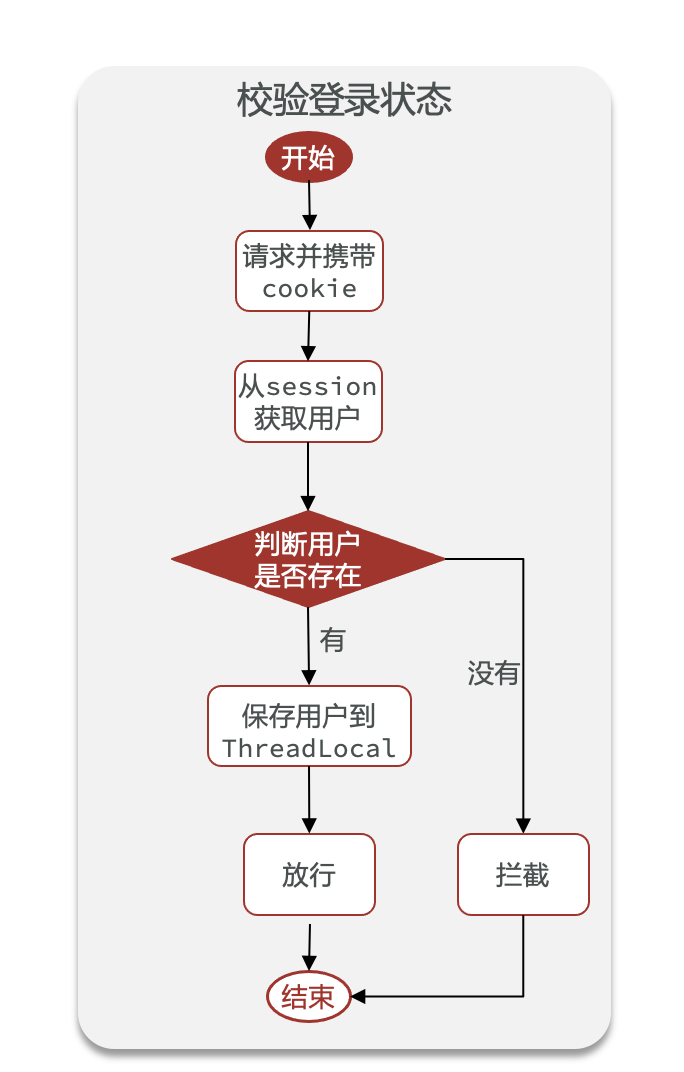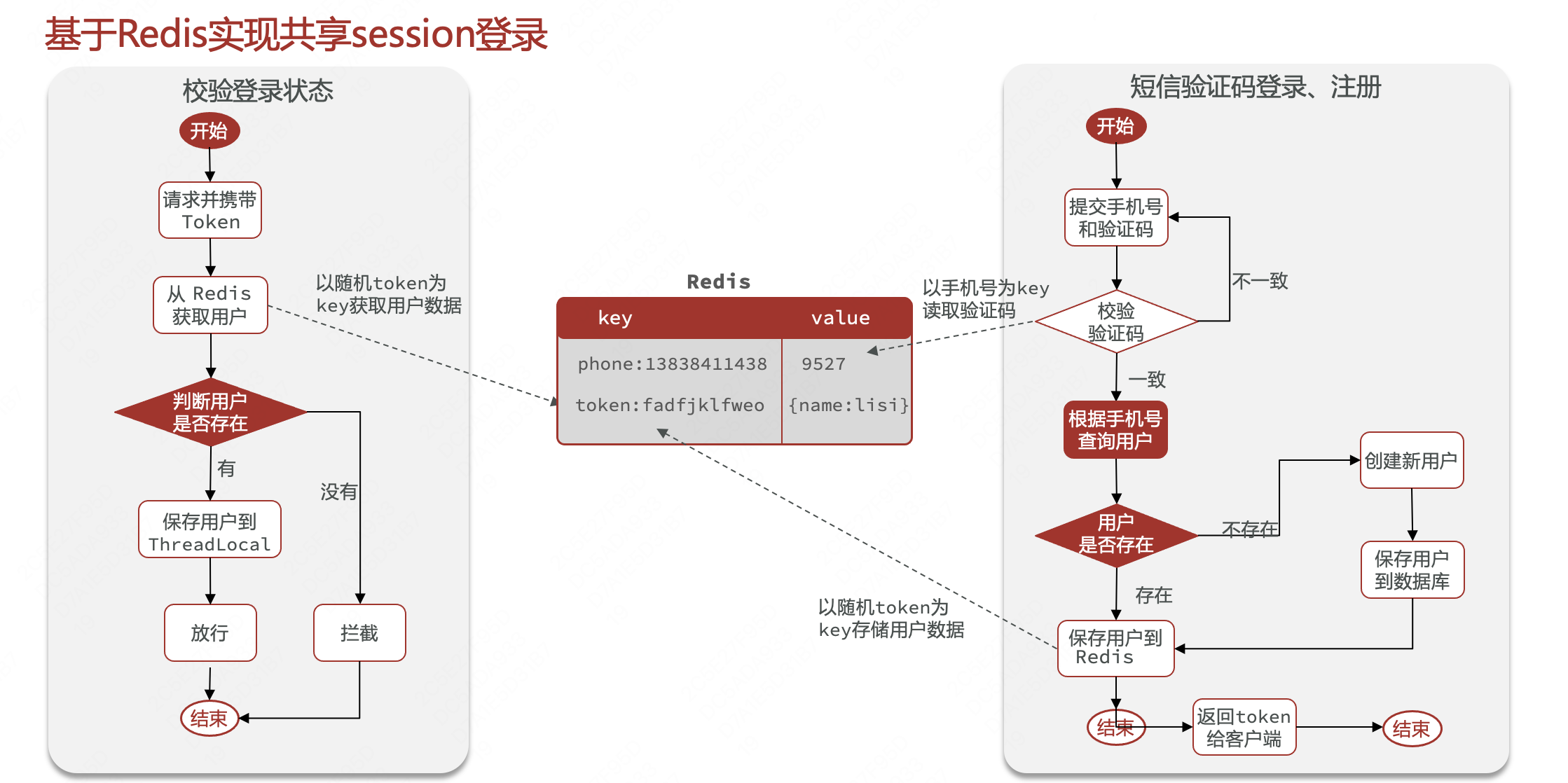1. Flowchart
Login status check under stand-alone node

Login status verification under distributed nodes

2. Code implementation
The implementation steps are divided into the following steps
- Implement the WebMvcConfigurer interface and add interceptors
- To define an interceptor, you need to configure two interceptors, the first one is used to refresh the token and write threadlocal, and the second one is used to determine whether there is user login information in threadlocal
q1: Why are two interceptors defined here? Put the logic of refreshing the token into LoginInterceptor to implement
a1: the reason is that LoginInterceptor is configured with page path exclusion, LoginInterceptor only checks the pages that need to be logged in, and directly releases those that do not need to log in, and will not execute the preHandle method. If the token is refreshed Putting it in LoginInterceptor will cause the user to operate on a page that does not need to log in. After a while, the user will still be reminded that he has not logged in.
a. Implement the WebMvcConfigurer interface and configure the interceptor
package com.hmdp.config;
import com.hmdp.utils.LoginInterceptor;
import com.hmdp.utils.RefreshTokenInterceptor;
import org.springframework.context.annotation.Configuration;
import org.springframework.data.redis.core.StringRedisTemplate;
import org.springframework.web.servlet.config.annotation.InterceptorRegistry;
import org.springframework.web.servlet.config.annotation.WebMvcConfigurer;
import javax.annotation.Resource;
@Configuration
public class MvcConfig implements WebMvcConfigurer {
@Resource
private StringRedisTemplate stringRedisTemplate;
@Override
public void addInterceptors(InterceptorRegistry registry) {
// 登录拦截器
registry.addInterceptor(new LoginInterceptor())
.excludePathPatterns(
"/shop/**",
"/voucher/**",
"/shop-type/**",
"/upload/**",
"/blog/hot",
"/user/code",
"/user/login"
).order(1);
// token刷新的拦截器
registry.addInterceptor(new RefreshTokenInterceptor(stringRedisTemplate)).addPathPatterns("/**").order(0);
}
}
b. Define the interceptor interceptor
Two interceptors need to be configured, the first one is used to refresh token and write threadlocal, and the second one is used to judge whether there is user login information in threadlocal
The first one is used to retrieve the user's login information from redis and maintain the login information into threadlocal
package com.hmdp.utils;
import cn.hutool.core.bean.BeanUtil;
import cn.hutool.core.util.StrUtil;
import com.hmdp.dto.UserDTO;
import org.springframework.data.redis.core.StringRedisTemplate;
import org.springframework.web.servlet.HandlerInterceptor;
import javax.servlet.http.HttpServletRequest;
import javax.servlet.http.HttpServletResponse;
import java.util.Map;
import java.util.concurrent.TimeUnit;
import static com.hmdp.utils.RedisConstants.LOGIN_USER_KEY;
import static com.hmdp.utils.RedisConstants.LOGIN_USER_TTL;
public class RefreshTokenInterceptor implements HandlerInterceptor {
private StringRedisTemplate stringRedisTemplate;
public RefreshTokenInterceptor(StringRedisTemplate stringRedisTemplate) {
this.stringRedisTemplate = stringRedisTemplate;
}
@Override
public boolean preHandle(HttpServletRequest request, HttpServletResponse response, Object handler) throws Exception {
// 1.获取请求头中的token
String token = request.getHeader("authorization");
if (StrUtil.isBlank(token)) {
return true;
}
// 2.基于TOKEN获取redis中的用户
String key = LOGIN_USER_KEY + token;
Map<Object, Object> userMap = stringRedisTemplate.opsForHash().entries(key);
// 3.判断用户是否存在
if (userMap.isEmpty()) {
return true;
}
// 5.将查询到的hash数据转为UserDTO
UserDTO userDTO = BeanUtil.fillBeanWithMap(userMap, new UserDTO(), false);
// 6.存在,保存用户信息到 ThreadLocal
UserHolder.saveUser(userDTO);
// 7.刷新token有效期
stringRedisTemplate.expire(key, LOGIN_USER_TTL, TimeUnit.MINUTES);
// 8.放行
return true;
}
@Override
public void afterCompletion(HttpServletRequest request, HttpServletResponse response, Object handler, Exception ex) throws Exception {
// 移除用户
UserHolder.removeUser();
}
}
The second reads user information from threadlocal to determine whether the user is logged in
import org.springframework.web.servlet.HandlerInterceptor;
import javax.servlet.http.HttpServletRequest;
import javax.servlet.http.HttpServletResponse;
public class LoginInterceptor implements HandlerInterceptor {
@Override
public boolean preHandle(HttpServletRequest request, HttpServletResponse response, Object handler) throws Exception {
// 1.判断是否需要拦截(ThreadLocal中是否有用户)
if (UserHolder.getUser() == null) {
// 没有,需要拦截,设置状态码
response.setStatus(401);
// 拦截
return false;
}
// 有用户,则放行
return true;
}
}